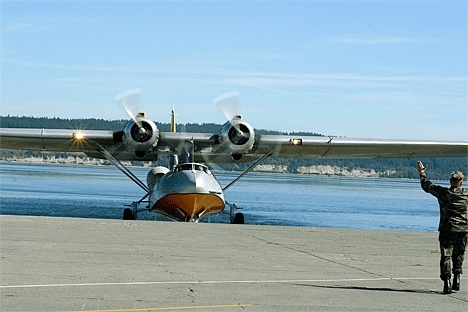A huge Oak Harbor crowd Friday afternoon welcomed the return of the legendary PBY Catalina the Seaplane Base after an absence of six decades.
At 12:48 p.m., just 12 minutes shy of its landing, the PBY Catalina made a sweep over the base as the multitude craned their necks to get a glimpse at it.
“The old cat looks the same,” Win Stites, PBY Memorial Foundation president, said, standing among the throng anxious to renew their acquaintance with the beloved flying and floating warhorse.
Stites patrolled the North Pacific for a year and a half as a flight engineer, and was one of many at the fly-in ceremony with memories of the old, flying boats.
The aircraft made its landing in Crescent Harbor and it’s one of only 21 remaining airworthy PBY Catalinas.
It will remain on the Seaplane Base for the next week, open for public view.
Oak Harbor resident Beverly Souza says she remembers the planes as a child, when she was a part of the “waterfront gang.” Kids were allowed to play around the airplanes on the Seaplane Base and even crawl on them, she said.
“We would pick up driftwood and pretend to shoot at them,” Souza said. “It was an exciting time to be a kid here.”
The Seaplane Base saw its first Catalina in Dec. 1942 and the population in Oak Harbor soon tripled. There were 16 squadrons in Oak Harbor, Stites said, and there were 20 to 30 seaplanes tied to the ramps at a time.
In World War II, PBYs were used in patrol bombing, convoy escorts and search and rescue missions, among others.
Oak Harbor residents became accustomed to PBY planes training for missions in the Aleutian Islands, Stites said, where Japanese forces had attacked.
During Friday’s landing, base security asked the crowd to move behind fire trucks after the plane touched the water and pulled in. The nose wheel didn’t lock into place as it came up the ramp, so the plane backed up for a second attempt.
The crowd quickly swarmed the Catalina for a closer inspection.
“In the past, guys in wet suits would attach the wheels and a tractor would pull it up,” Stites said.
Stites described the Catalina as the “finest example of the remaining planes.” It’s owned by Bud Rude of Spanaway and piloted by Fred Owens and Craig Haws.
The PBY landing followed a National Prisoners of War/Missing in Action Recognition Day service at the Memorial Fountain.
The guest speaker Lt. Cmdr. Brian Danielson, a member of the National League of Families for POW/MIAs whose father was shot down over Laos in 1965.
Danielson joined an expedition in 2006 to search for his father’s remains. The team found a DNA match, and his family was able to hold a memorial in 2007, nearly 37 years after his death in combat during the Vietnam war.
“One of the amazing aspects was to see 250 motorcycles show up and form a perimeter of flags around the whole church,” Danielson said.
The Brothers in Arms Motorcycle Club donated a POW/MIA flag for the afternoon ceremony.
“We hope these ceremonies can go on,” Chris Gomes, president of the motorcyle club said. “We can’t forget until all of them come home.”
Butch Larsen, a four-year prisoner of the Japanese, helped raise the POW/MIA flag as the Electronic Attack Squadron 129 performed a formation fly-by.
Members of the Oak Harbor High School band opened the ceremony with the “Star Spangled Banner.”



